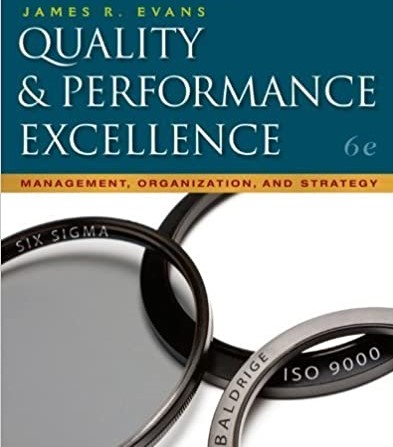
Quality & Performance Excellence 6th Edition by James Evans
Edition 6ISBN: 978-0324827064
Quality & Performance Excellence 6th Edition by James Evans
Edition 6ISBN: 978-0324827064 Exercise 8
Situational Leadership in Action
A large pharmaceutical manufacturer was highly motivated to meet quality challenges. It implemented an ISO 9000-compatible quality system to ensure not only FDA compliance requirements, but also customer satisfaction. As the manufacturing plants of the organization were audited by the internal audit division, it became apparent that some plants were meeting the challenge, while others continued to struggle in both the quality and the regulatory aspects of production. This fact was evident in the reports of internal findings and in FDA inspection reports.
For the most part, the manufacturing plants share consistent resources and face similar environments. All were issued the responsibility of meeting the expectations of the quality system through the same mechanism. All understood the consequence of not conforming, that is, of jeopardizing their manufacturing license as bound by the consent decree. The issue then became why some plants could successfully design and implement the requirements of the quality system, whereas others could not and still cannot.
Although the plants are similar in many ways, they differ in terms of leadership, as each plant has its own CEO. The CEO, as the leader of his or her plant, has the responsibility of ensuring the successful implementation of a quality system. The plants also differ in their organizational members, those who are to be led by the CEO. The relationship between the leader and the organizational members is critical to a plant's ability to implement an effective quality system, with effectiveness being a measure of how successfully a plant can comply with FDA regulations and internal quality standards.
Both plants have a similar culture that can be best described as conserving, reflecting a level of rigidity in response to the external environment, but demonstrating organizational commitment. The strategy used by the leader in Plant A was a combination of moderate to high amounts of structuring actions, with high to moderate amounts of inspiring actions, whereas the strategy used by Plant B's CEO was a combination of moderate to low amounts of structuring actions, with moderate to high amounts of inspiring actions.
Discussion Question
What type of situational leadership style did the CEO of each plant demonstrate
A large pharmaceutical manufacturer was highly motivated to meet quality challenges. It implemented an ISO 9000-compatible quality system to ensure not only FDA compliance requirements, but also customer satisfaction. As the manufacturing plants of the organization were audited by the internal audit division, it became apparent that some plants were meeting the challenge, while others continued to struggle in both the quality and the regulatory aspects of production. This fact was evident in the reports of internal findings and in FDA inspection reports.
For the most part, the manufacturing plants share consistent resources and face similar environments. All were issued the responsibility of meeting the expectations of the quality system through the same mechanism. All understood the consequence of not conforming, that is, of jeopardizing their manufacturing license as bound by the consent decree. The issue then became why some plants could successfully design and implement the requirements of the quality system, whereas others could not and still cannot.
Although the plants are similar in many ways, they differ in terms of leadership, as each plant has its own CEO. The CEO, as the leader of his or her plant, has the responsibility of ensuring the successful implementation of a quality system. The plants also differ in their organizational members, those who are to be led by the CEO. The relationship between the leader and the organizational members is critical to a plant's ability to implement an effective quality system, with effectiveness being a measure of how successfully a plant can comply with FDA regulations and internal quality standards.
Both plants have a similar culture that can be best described as conserving, reflecting a level of rigidity in response to the external environment, but demonstrating organizational commitment. The strategy used by the leader in Plant A was a combination of moderate to high amounts of structuring actions, with high to moderate amounts of inspiring actions, whereas the strategy used by Plant B's CEO was a combination of moderate to low amounts of structuring actions, with moderate to high amounts of inspiring actions.
Discussion Question
What type of situational leadership style did the CEO of each plant demonstrate
Explanation
The leader in Plant A used moderate to h...
Quality & Performance Excellence 6th Edition by James Evans
Why don’t you like this exercise?
Other Minimum 8 character and maximum 255 character
Character 255


